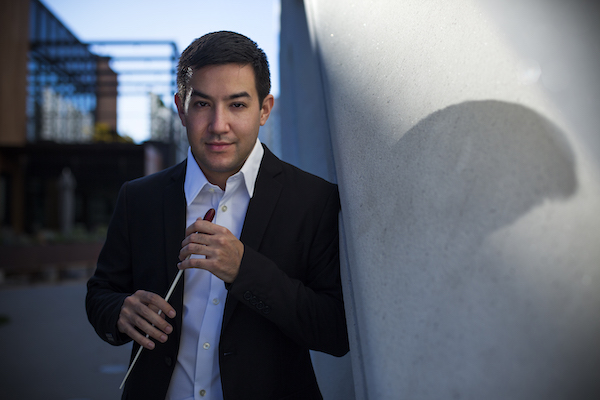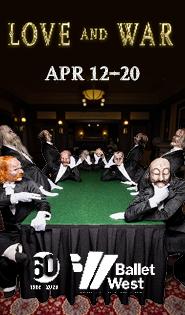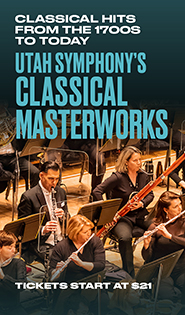An oddly irony-free Shostakovich No. 5 from Lecce-Chong with Utah Symphony

As Russia’s invasion of Ukraine rages on, many American concert presenters feel compelled to do or say something on behalf of the Ukrainian people. When a program includes a symphony by Dmitri Shostakovich – a composer deeply associated with Soviet Russia – the situation requires additional sensitivity and judgment.
The part-time, semi-professional Salt Lake Symphony canceled its performance of Shostakovich’s Symphony No. 12 planned for later this month: Music director Robert Baldwin explained that the piece is seen as glorifying the Russian revolution and the former Soviet Union, and therefore could be seen as supporting the martial, pro-Soviet rhetoric that Russian President Vladimir Putin has employed to justify his “special military operation.”
Utah Symphony, for its part, went ahead with a performance of Shostakovich’s fifth symphony on Friday at Abravanel Hall, after a word from president and chief executive Steven Brosvik and a rousing rendition of the Ukrainian National Anthem. Brosvik introduced the symphony, which made up the concert’s second half, as an “ode to humanity.” He expressed the widely accepted view that the piece was the composer’s covert protest against Stalin’s repressive regime, and that its triumphant martial passages were meant sarcastically.
Right before then, at intermission, quotes from Shostakovich himself about the piece and the Soviet regime were projected on stage, interspersed with lines from the Ukrainian National Anthem — a display that drew smatterings of applause.
Interestingly, the orchestra’s performance of the piece, under the baton of debuting guest conductor Francesco Lecce-Chong, was bereft of the musical sarcasm present in other interpretations; the often-sardonic second movement sounded straightforwardly triumphant and the fourth was genuinely joyful and exciting. Lecce-Chong’s interpretation had some moments of stunning musicality, but if Stalin’s censors had been in attendance, even the most astute of them would have concluded that Shostakovich’s pro-Soviet sentiment was “on the level.”
The first movement began dramatically, with artful cut-offs and conscientious phrasing, but its disparate sections did not hang together as a whole. This may have been partly due to Lecce-Chong’s extreme variations in tempo, which were more dramatic than other interpretations. The softer passages were not imbued with hushed anticipation; they were merely quiet, and the more aggressive passages seemed rushed with unearned urgency.
Lecce-Chong gave the second movement more cohesion, but it was hindered by his dramatic swings in tempo. He masterfully phrased the pizzicato passages and brought a terrific sound out of the orchestra, but, as noted above, there was no sardonic undercurrent.
The symphony’s high point was the sweetly tragic third movement. Lecce-Chong’s phrasing was exquisite as he led the strings in a slowly building crescendo to dizzyingly effusive climax. Throughout the concert, Lecce-Chong seemed to prefer a dryer, less shimmering sound in the strings. At times, it made the orchestra sound stilted, but in the third movement of the Shostakovich, it added clarity and transparency, which highlighted the piece’s counterpoint and gave the music room to breathe. The strings provided stunning backdrop to the mournful, sensitively phrased solo passages by guest principal oboist Brooks Fisher and principal flutist Mercedes Smith.
Lecce-Chong and the orchestra also acquitted themselves well in the rousing fourth movement. The low brass and winds sounded particularly strong, and Lecce-Chong paid special attention to the movement’s varied textures and orchestral colors as he built to a powerful climax.
The concert’s first half featured Gabriela Lena Frank’s percussive 2010 piece Escaramuza and Mozart’s Piano Concerto No. 12 with returning Swiss pianist Louis Schwizgebel.
Written for five persussion instruments and strings, Escaramuza begins with a powerful bass drum solo, soon joined by contra snare drum, suspended cymbal and eventually marimba. For the first quarter of the nine-minute work, the strings serve mostly as off-beat rhythmic punctuation to the intricate percussion figures. When they eventually take a more melodic role, the strings sound a bit like contemporary Latin-American composers Ginastera and Marquez, but the piece is mostly about the percussion, which is meant to evoke the Kampacha rope dance performed by prehistoric Inca warriors, which the composer experienced during a visit to Peru during the Virgen de la Carmen festival.
The orchestra’s rendition was delightful. In addition to showcasing its top-notch percussion section, it also demonstrated the versatility of its string section. Lecce-Chong kept the cut-offs sharp and crisp and brought out the interesting sonorities in the cello and bass.
Few things in classical music evoke as much strong feeling and snobbery as the interpretation of Mozart’s piano works. Capturing the crystalline poetry in Mozart’s exposed melodic lines is a lifelong pursuit, and any pianist who attempts it will face comparison to such towering talents as Murray Perahia and Mitsuko Uchida.
In that sense, Schwizgebel and any other pianists who attempt to interpret Mozart should be commended for their bravery. When one shows a spark of originality, as Schwizgebel did in parts of his performance, he should be celebrated.
The first movement was well-executed but not distinctive. Part of that might have been due to Lecce-Chong’s tentative phrasing and the way he seemed to mute the strings, which left the orchestra sounding too quiet to fill the hall. Schwizgebel’s tone was a little too percussive, but his runs were clear and his articulation was crisp. In the first movement cadenza, he gestured toward something poetic, but his phrasing was too refined for it to fully come through.
In the second movement, Schwizgebel and Lecce-Chong seemed more sure of their interpretation. The orchestra came in with carefully sculpted phrasing, and Schwizgebel’s entrance was lucid and communicative. He gave the left-hand chords a Beethovenian sense of importance while the right-hand melody sang. The movement’s minor key passages had a serious, soulful quality and when the main theme came back again, it was filled with a sweet, captivating sense of longing that continued into the very exposed cadenza.
Schwizgebel gave the third movement a light, refined touch. The staccato Alberti bass under a crisply articulated melody gave the movement a buoyant quality. Like the first movement, his expressive flourishes were subdued to the point of being barely noticeable, but his flawless technique carried the day and brought him to a delightful finish.
Utah Symphony with guest conductor Tito Muñoz performs Beethoven, Sibelius and Buxtehude 7:30 p.m. Friday March 25 at Abravanel Hall, www.usuo.org.

